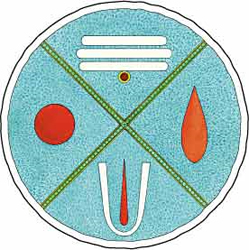The Four Hindu Sects
The spectrum of Hindu religiousness is found within four major sects or denominations: Śaivism, Śāktism, Vaishṇavism and Smārtism. Among these four streams, there are certainly more similarities than differences. Many of the ślokas and bhāshyas of Dancing with Śiva (Śivena saha Nartanam), Hinduism’s Contemporary Catechism (Hindu Dharma Samakālina Praśnottaram) have shown how they concur as well as differ. All four believe in karma and reincarnation and in a Supreme Being who is both form and pervades form, who creates, sustains and destroys the universe only to create it again in unending cycles. They strongly declare the validity and importance of temple worship, in the three worlds of existence and the myriad Gods and devas residing in them. They concur that there is no intrinsic evil, that the cosmos is created out of God and is permeated by Him. They each believe in māyā (though their definitions differ somewhat), and in the liberation of the soul from rebirth, called moksha, as the goal of human existence. They believe in dharma and in ahiṁsā, noninjury, and in the need for a satguru to lead the soul toward Self Realization. They wear the sacred marks, tilaka, on their foreheads as sacred symbols, though each wears a distinct mark. Finally, they prefer cremation of the body upon death, believing that the soul will inhabit another body in the next life. While Hinduism has many sacred scriptures, all sects ascribe the highest authority to the Vedas and Āgamas, though their Āgamas differ somewhat. Here, now, is a brief comparison of these four denominations.§
ŚAIVISM: Personal God and temple Deity is Śiva, neither male nor female. Lords Gaṇeśa and Kārttikeya are also worshiped. §
ŚĀKTISM: Personal Goddess and temple Deity is Śrī Devī or Śakti, female, worshiped as Rājarājeśvarī, Pārvatī, Lakshmī, Sarasvatī, Kālī, Amman, etc. —the Divine Mother. §
VAISHṆAVISM: Personal God and temple Deity is Vishṇu, male. His incarnations as Rāma and Kṛishṇa are also worshiped, as well as His divine consort, Rādhā Rāṇī. §
SMĀRTISM: Personal God and temple Deity is Īśvara, male or female, worshiped as Vishṇu, Śiva, Śakti, Gaṇeśa and Sūrya or any Deity of devotee’s choice, e.g., Kumāra or Kṛishṇa.§
ŚAIVISM: Śakti is God Śiva’s inseparable power and manifest will, energy or mind.§
ŚĀKTISM: Śakti is an active, immanent Being, separate from a quiescent and remote Śiva.§
VAISHṆAVISM: No special importance is given to Śakti. However, there are parallels wherein the divine consorts are conceived as the inseparable powers of Vishṇu and His incarnations: e.g., Kṛishṇa’s Rādhā Rāṇī and Rāma’s Sitā.§
SMĀRTISM: Śakti is a divine form of Īśvara. It is God’s manifesting power.§
ŚAIVISM: God Śiva is pure love and compassion, immanent and transcendent, pleased by our purity and sādhana.§
ŚĀKTISM: The Goddess Śakti is both compassionate and terrifying, pleasing and wrathful, assuaged by sacrifice and submission.§
VAISHṆAVISM: God Vishṇu is loving and beautiful, the object of man’s devotion, pleased by our service and surrender.§
SMĀRTISM: Īśvara appears as a human-like Deity according to devotees’ loving worship, which is sometimes considered a rudimentary self-purifying practice.§
ŚAIVISM: There are no divine earthly incarnations.§
ŚĀKTISM: The Divine Mother does incarnate in this world.§
VAISHṆAVISM: Vishṇu has ten or more incarnations.§
SMĀRTISM: All Deities may assume earthly incarnations.§
ŚAIVISM: God Śiva is one with the soul. The soul must realize this advaitic Truth by God Śiva’s grace.§
ŚĀKTISM: The Divine Mother, Śakti, is mediatrix, bestowing advaitic moksha on those who worship Her. §
VAISHṆAVISM: God and soul are eternally distinct. Through Lord Vishṇu’s grace, the soul’s destiny is to worship and enjoy God.§
SMĀRTISM: Īśvara and man are in reality Absolute Brahman. Within māyā, the soul and Īśvara appear as two. Jñāna dispels the illusion.§
ŚAIVISM: With bhakti as a base, emphasis is placed on sādhana, tapas and yoga. Ascetic.§
ŚĀKTISM: Emphasis is on bhakti and tantra, sometimes occult, practices. Ascetic-occult.§
VAISHṆAVISM: Emphasis is on supreme bhakti or surrender, called prapatti. Generally devotional and nonascetic.§
SMĀRTISM: Preparatory sādhanas are bhakti, karma, rāja yoga. The highest path is through knowledge, leading to jñāna.§
ŚAIVISM: Vedas, Śaiva Āgamas and Śaiva Purāṇas.§
ŚĀKTISM: Vedas, Śākta Āgamas (Tantras) and Purāṇas.§
VAISHṆAVISM: Vedas, Vaishṇava Āgamas, Purāṇas and the Itihāsas (Rāmāyaṇa and Mahābhārata, especially the Bhagavad Gītā).§
SMĀRTISM: Vedas, Āgamas and classical smṛiti—Purāṇas, Itihāsas, especially the Bhagavad Gītā, etc.§
ŚAIVISM: Geographically widespread, strongest in South and North India, Nepal and Sri Lanka.§
ŚĀKTISM: Geographically widespread, most prominent in Northeast India, especially Bengal and Assam.§
VAISHṆAVISM: Geographically widespread, especially strong throughout India, North and South.§
SMĀRTISM: Geographically widespread, most prominent in North and South India.§
